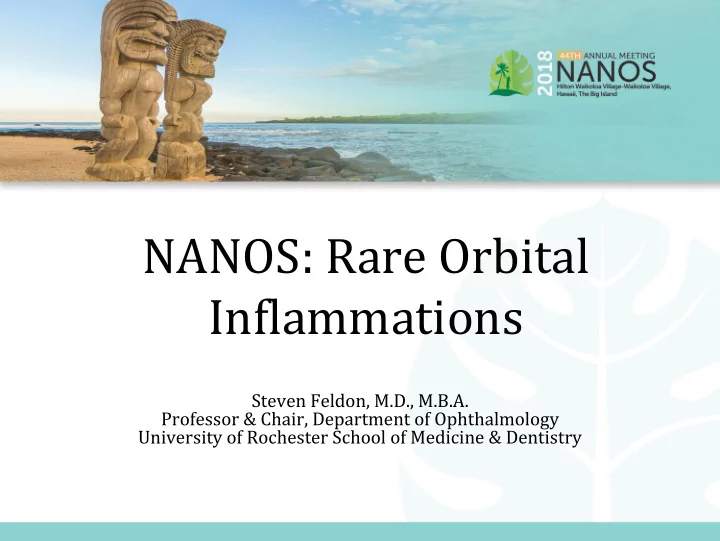

NANOS: Rare Orbital Inflammations Steven Feldon, M.D., M.B.A. Professor & Chair, Department of Ophthalmology University of Rochester School of Medicine & Dentistry
Relevant Financial Disclosures I do not have any financial interests or relationships to disclose. •
Differential Diagnosis of Non-idiopathic Orbital Inflammatory Disease Sarcoidosis • Churg-Strauss Syndrome • Wegener’s Granulomatosis: Granulomatosis with Polyangiitis (GPA) • Giant Cell Arteritis • Adult Xanthogranulomatous Diseases • Rosai-Dorfman •
Sarcoidosis Demographics: 3 rd and 6 th decade; M=F • Incidence: 60/100K Scandinavia; 35/100K in AA’s and 11/100K in US for • Caucasians Post- 911, the incidence of sarcoid lung disease in NYFD’s responders was • 86/100K (primarily pulmonary), suggesting environmental trigger Systemic findings: pulmonary>skin>neuroaxis • Ocular findings: uveitis of any type; lid granulomas • Orbit: bilateral disease in 50%, systemic manifestations in 70%, lacrimal • gland involvement in 55%, discrete mass in 20%, nerve sheath in 20% Pathology: non-caseating granulomas, giant cells, Schumann body inclusions, • background fibrosis Test: ACE, lysozyme, imaging enhances • Treatment: steroids, cyclosporine, azothioprine systemically; may benefit • some patient with steroid injection locally into lesion
Am J Ophthalmol. 2007 Nov;144(5):769-775. Diverse clinical presentations of orbital sarcoid. Mavrikakis I 1 , Rootman J.
Churg-Strauss Syndrome Demographics: 5th decade peak • Incidence: • Systemic findings: Asthma, rash, pain/numbness in extremities, malaise, night • sweats, bleeding Ocular findings: • Ischemic presentation: amaurosis, ION, BRAO or CRAO • Infiltrative presentation: lid swelling, episcleritis, periscleritis, • conjunctival granulomas, dacryoadenitis, thickened optic nerve sheaths Pathology: eosinophilic infiltration of granulomatous inflammation; • vasculitis Test: B scan choroidal thickening in macula; weak + ANCA • Treatment: steroids, methotrexate, cytotoxic drugs for refractory states •
Ophthalmology. 2001 Jun;108(6):1129-33. Orbital inflammatory pseudotumor and ischemic vasculitis in Churg-Strauss syndrome: report of two cases and review of the literature. Takanashi T 1 , Uchida S, Arita M, Okada M, Kashii S
Granulomatosis with Polyangiitis (GPA) Demographics: peak 5 th -8 th decade; M=F, Caucasions • Incidence: .4-8/100K • Systemic findings: upper airway including sinus involvement in 90%; • classical nasal septal perforation; frequent lung and renal involvement Ocular findings: episcleritis, scleritis, keratitis, retinal vasculitis • Orbit: bilateral dacryoadenitis, orbital fibrosis • Pathology: fat necrosis with giant cells, free vacuoles, fibrosis • Test: cANCA + in >90% • Treatment: corticosteroids plus cyclophosphomide, methotrexate or • azathioprine; some anti TNF and anti CD20 monoclonals may be helpful
Semin Arthritis Rheum. 2006 Apr;35(5):284- 92. Wegener's granulomatosis: ophthalmic manifestations and management. Pakrou N 1 , Selva D, Leibovitch I.
Am J Med. 2004 Jul 1;117(1):39-50. The antineutrophil cytoplasmic antibody-associated vasculitides. Seo P 1 , Stone JH
Giant Cell Arteritis Demographics: peak 8 th decade, Caucasian, M:F = 1:2 • Incidence: rare orbital involvement • Systemic findings: headache, neck pain, jaw claudication, scalp tenderness, • polymyalgia, weight loss Ocular findings: AION in 20%, CRAO, amaurosis fugax, diplopia • Orbit: diffuse orbital inflammation • Pathology: epithelioid cells, giant cells, round cell infiltration • Test: CRP, sed rate, biopsy • Treatment: hi dose corticosteroids, methotrexate, azathioprine, cyclosporine, • immunomodulatory drugs (tocilizumab, abatacep, ustakinumab) •
Graefes Arch Clin Exp Ophthalmol. 2001 Jul;239(7):509-13. Orbital presentations of giant cell arteritis. Lee AG 1 , Tang RA, Feldon SE, Pless M, Schiffman JS, Rubin RM, Rao N
Adult Xanthogranulomatous Disease (AOX, AAPOX; NBX, ECD) Demographics: peak in 6 th decade; M=F • Systemic findings: • AAPOX is associated with asthma and lymphadenopathy • NBX is associated with paraproteinemia/myeloma • ECD is characterized by pulmonary, cardiac, and retroperitoneal fibrosis, • as well as bone involvement Ocular findings: eyelid masses • Orbit: dacryoadenitis, diffuse infiltrative process • Pathology: foamy histiocytes (CD68+), Touton giant cells spindle cells, • mononuclear infiltrate. Test: paraproteins, lymph node biopsy • Treatment: multi-agent chemo with or without radiation; combo • cyclosporine and cyclophosphamide
Dermatol Clin. 2015 Jul;33(3):457-63. doi: 10.1016/j.det.2015.03.010. Epub 2015 May 8. Adult Orbital Xanthogranulomatous Disease: A Review with Emphasis on Etiology, Systemic Associations, Diagnostic Tools, and Treatment. Kerstetter J 1 , Wang J 2
Rosai-Dorfman Demographics: M>F; 80% are <21 years old • Incidence: rare • Systemic findings: lymphadenopathy of head and neck; respiratory tract, • salivary glands, skin, bone, meninges, CNS, testes Ocular findings: rare scleritis, uveitis, marginal corneal ulcers, choroidal • mass, lid lesions Orbit: often sinus involvement, bilateral dacryadenitis; enhancing • homogeneous mass on T1 MRI and only rare bony destruction Pathology: Emperipolesis (lymphoctyes found phagocytized by large • histiocytes; lymph node architecture in extranodal locations; scattered mixed inflammatory reaction Test: anemia, polyclonal hypergammaglobulinemia • Treatment: Excision or debulking of masses. Spontaneous remission possible. • Radiation, steroids and chemo for recurrent or unresponsive cases
Ophthal Plast Reconstr Surg. 2016 Nov/Dec;32(6):458- 461. Extranodal Rosai-Dorfman Disease of the Orbit: Clinical Features of 8 Cases. Tan JJ 1 , Narang S, Purewal B, Langer PD, Blaydon S, Schwarcz RM, McCormick SA, Kim JY, Walrath JD, Burt BO, Shinder R
Ocular Disease Truth Table Disease Uveitis Scleritis Epi- Keratitis Choroid Retinal ION CRAO or Lid Mass scleritis Vasculitis BRAO Sarcoid X X X Churg- X X X X X (conj) Strauss GPA X X X X GCA X X AAPOX X NBX X Rosai- X X X X X Dorfman
Systemic Disease Truth Table Disease Asthm Sinus Skin CNS Lung Other Bone cANC Para- a organs A proteins Sarcoid X X X Churg- X X X Strauss GPA X X X X GCA AAPOX X NBX X ECD X X X X Rosai- X X X X X X X Dorfman*
SUMMARY Non-idiopathic orbital inflammation should be suspected when: • The inflammation is bilateral • There is ocular involvement • There are systemic symptoms or signs • There is a characteristic biopsy Treatment consists of: 1. Biopsy of orbit, skin or other involved organ 2. Corticosteroids (localized or systemic) 3. Immune suppression 4. Targeted biologicals
Recommend
More recommend